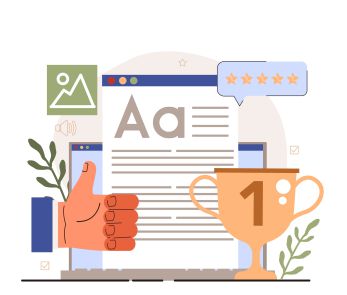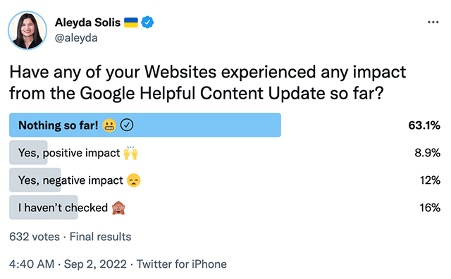Write for people first, and search engines second.
It’s a motto that Google has trumpeted from the rooftops for years, though it’s also one that hasn’t always been the easiest to follow. After all, anybody who spends a few minutes scrolling through Google’s search results is sure to come across content that doesn’t offer the answer to their query, seemingly AI-generated, stuffed with keywords, or written for algorithms ahead of people in some other way.
Google knows this, too, and it’s nothing if not persistent in its efforts to deliver people-first content to its audience.
Enter the “Helpful Content Update.”

What is the Google Helpful Content Update?
Released in August 2022 as a major update to Google’s core search algorithm, the Helpful Content Update is designed to do one thing – make sure Google’s users see value-driven content ahead of keyword-riddled guff.
The message from Google was simple – our latest update is about rewarding original content writing. Google Search Central was quick to elaborate on what this update would target, with Google telling website owners the following:
The changes are about improving how our systems assess content overall. These changes may cause some previously under-rewarded pages to do better in search results.
That’s what Google tends to say about all of its core algorithm updates. So, as is often the case, Google is a little vague about exactly what its latest core update does. That follows the company’s general pattern regarding its search algorithm, with the general information available for all but the technical stuff hidden behind the veil. But what we can see from this is that Google aims to reward original content writing with the rankings that it deserves.
Heading to Google’s Search Central documentation related to the update, we get a little more information. Google is quick to point out that it wants to prioritize content written for people (i.e., people-first content) ahead of content written solely for gaming the search rankings. So, assuming this update works as intended, what we should see is keyword-riddled content that offers little to nothing new to readers taking a tumble, with content that demonstrates true mastery over the topic it covers taking its place.

What is People-First Content?
Before we dig into how the Helpful Content Update might impact your website and what you can do about it, it’s worth taking a diversion to explore what people-first content is.
To Meerkerk, people-first content is the core of our article writing services. The idea is to create content that offers more than a surface-level examination of a subject, instead diving so deep into the topic that readers can’t deny the expertise behind the keyboard.
Of course, people-first content needs to be written well in the sense that it’s coherent and not riddled with grammatical errors. But the key is original content writing that delivers something valuable to readers, resolving their search queries and leaving them satisfied.
And “readers” is the operative word here.
The people who use Google always have questions for which they need answers. Sometimes, those questions are simple enough that they don’t need pages written about them, such as “Who was the first person to land on the moon?” Other times, those questions are more nuanced, requiring the results that Google shares to dig into the topic in more detail.
For example, you may have searched for a term like “How will the Google helpful content update affect my website” to find this article. That means you want to learn what the update is, what type of content it will promote, and how to create that content.
So, we’ll aim to answer those questions using our expertise derived from years of writing content for ourselves and our clients. As a reader, you’re more likely to trust what we write because we have a track record of creating great content. And as content creators, we’ll write to answer your questions rather than land an article at the top of Google’s search results for a bunch of keywords that may only be semi-related to the topic.
That’s taking a people-first approach – we write based on the experience and authority that over a decade and counting of writing quality content provides.

A Quick Word on Authority
We mentioned “authority,” though we haven’t defined what that means in the context of people-first content.
Essentially, content with a people-first approach enables you to build authority in your niche. By addressing and solving your readers’ problems, providing correct, factual information, and offering expert advice based on experience and know-how, your website will become a one-stop shop, a trustworthy source they will consult anytime in need.
Authority is the essence of original content writing for three reasons:
1. Differentiation From Competitors
If your reader can learn about the topic from somebody else, especially somebody already well-established as a brand, why would they come to you for information? Differentiation is as critical in content as it is in business, with authority being derived from the information you can provide that nobody else can offer.
2. Showcasing Expertise
You know a lot about your topic, and your readers want to absorb that knowledge. At least, you should know a lot if you want to deliver content with any sense of authority. Suppose it’s clear that you’ve cobbled something together that’s essentially a copy-and-paste job from somebody else. In that case, you’re telling readers that they may as well go to the source because you have nothing worth saying.
3. Combining the Facts with Knowledge-Driven Opinions
When you get people-first content right, you’ve found a way to combine the factual aspects of your writing with the value inherent in your opinions. This article can be a great example. On the factual side, we’ve told you what the Google Helpful Content Update is, and we’re about to tell you how it’s likely to affect your website. Beyond those facts, we deliver value based on our expertise, which we’re doing here with an explanation of authority and will do later when we look at what we think you need to do to create the kind of content that Google wants to see.
Strike that balance between facts and knowledge-driven opinions, and your readers will see you as a trustworthy resource, meaning you have authority.
How Will the Helpful Content Update Affect Your Website?
In a perfect world, your website is already so full of value-driven content that you will see page after page climbing up in the rankings. But we know that reality isn’t always so kind, as we see from this quick survey conducted by SEO professional Aleyda Solis and shared by Search Engine Roundtable:

As this survey came out about a week after the Google Helpful Content Update, it perhaps isn’t fully indicative of the algorithm change’s effects. Even so, we see that about two-thirds (63.1%) of respondents claim that change did not affect their sites. That’s something of a win, at least in the sense that those sites didn’t see noticeable declines in rankings. But when it comes to those who saw changes, 8.9% saw improvements, while 12% experienced negative effects.
So, we see a slim majority of people experiencing a downward swing in search results. You may follow in their footsteps if your site hosts the type of content that Google’s targeting with this update, which includes the following:
- AI-generated content that hasn’t been tweaked for relevance and quality, meaning anything you’re pulling directly from Jasper, ChatGPT, or similar software packages.
- Any content you’ve written solely for ad monetization, such as list articles spread across multiple pages that offer minimal value but force the reader to wade through dozens of ads.
- Articles created for the clicks, which include anything laden with keywords that aren’t relevant or force the article to go off on unrelated tangents.
- Content that is unhelpful or unsatisfying such as any tech-related tutorials, educational materials, and reviews that aim to offer guidance but fail to deliver anything new beyond what’s already available online.
Combine those four types of content, and you have the antithesis of the people-first approach. Writing for clicks and ads means you’re not writing for people, whereas rehashing what’s already been written or having an AI do the job for you means your pieces don’t contain the authority that can only come from personal knowledge and experience.

How to Master the People-First Approach
If you’re part of the 12% of website owners who experienced a SERP-related tumble in the wake of the Helpful Content Update, it’s clear that there’s a value issue in your content. These tips can help you tweak what you already have on your site, in addition to being a checklist for any new content you write.
Tip 1 – Ask Yourself Who Can Use Your Content
This may seem like the most obvious tip in the world, but it’s an approach that tends to fall by the wayside when you’re writing to get a ranking rather than solve a problem.
Run an audit on every piece of content your website hosts, from product pages to blog articles. For each piece, ask yourself who, if anybody, will get something of value from it. What questions does it pose? What solutions does it provide? Can you honestly say that somebody who reads the piece in question will come away from it feeling like they’ve learned something they can apply to their problem?
If your answers to those questions (especially the last one) suggest that the piece has no real use to a reader, you either need to tweak it to turn it into value-driven content or get rid of it altogether.
Tip 2 – Stick to What You Know
We come back to the authority issue with this tip, as authority comes from sharing what you know with your audience. As providers of high-quality article-writing services, we know what we’re talking about when it comes to structuring content and what that content needs to offer to perform well in search engines.
Would you come to us for advice on how to fix a broken car engine?
Of course, you wouldn’t. That’s not our niche, and we’re not authorities in that area. The same applies to the people who visit your website, who know what you’re all about and will instantly get a whiff of something not being right if you start sharing content that’s outside of your established niche. What you know is where your authority lies, so create content that builds on your existing knowledge base rather than trying to venture into the uncharted waters of topics for which you have no experience.
Tip 3 – Give Your Topics a Little Extra Oomph
Sharing the basic facts about a subject is all well and good, but those facts are often things your readers can find elsewhere. For example, you could go to Google itself to learn more about the Helpful Content Update, which would make this article pointless if all we did was tell you what the update is.
The true value of this piece comes from our explanations of what people-first content is, what you have to avoid so you don’t get stung by the update, and what you can do to create content that will perform well. In other words, we’ve drawn from our expertise to elaborate on the facts we’ve shared, which gives this article more value for readers. Taking the same approach with your pieces means looking for where you can build on the facts to share something only you can offer.
Tip 4 – Go Beyond What the Tools Tell You
Tools like Clearscope and SurferSEO make their money by helping people create keyword-rich content that’s based on what’s already performing well in Google. That’s not a bad thing, as these tools can give you some indications of what your audience wants to read about and can even help you structure articles in ways that make sense to readers.
However, relying on these tools alone, or any keyword research, means you’re veering into “writing for search engines” territory. Remember that no tool can tell you exactly what your readers want to learn from your articles. They can give you prompts and even reveal the questions your readers need answers to, but they’re not the be-all and end-all of article writing. Whether it comes down to writing to satisfy a tool or your readers, it’s your readers who should win every single time.

Tip 5 – Write to Answer the Question, Not to Satisfy a Word Count
You’ve probably heard that Google has a preferred word count for articles. Yoast tells us that a regular page or blog post should contain at least 300 words, while Content Marketing Institute points to research that suggests that pieces between 1,000 and 2,000 words in length tend to perform better in rankings.
As for Google itself, it tells us that the perfect word count is:
However many words you need to answer the question you’ve posed in your article.
In other words, there’s no magic number regarding how many words your article should contain. If you can answer a question in a few dozen words, then that’s all you need to write. If the piece requires 5,000 words to give a comprehensive answer, you shouldn’t limit yourself to 1,000 because you read somewhere that Google wants articles of that length.
Writing to a word count means you’re writing for an algorithm rather than for people. By all means, set yourself a target or come into an article with an idea of how much you want to write. But if you need more (or less) to provide value, don’t let your initial target hold the resulting article back.
Tip 6 – Remember What Search Engine Optimization (SEO) is Actually About
SEO has evolved countless times since the advent of Google, though it’s fair to say that most SEOs, even today, are looking to achieve one thing:
Getting to the top of Google’s rankings.
The problem is that this quest for rankings is what leads to Google creating specific algorithms to find people-first content in the first place. Too many SEOs, and those influenced by those SEOs, take things too far when writing content, to the point where they’re writing for the ranking rather than the person.
Those people have forgotten the core purpose of SEO – to make it as easy as possible for search engines to discover and understand the content you share.
That understanding doesn’t come from layering keyword after keyword into your content, nor from only writing about topics you think have a chance of ranking well. As long as you handle the basics, such as writing an appropriate meta description and ensuring that your article sticks to a single topic, the rankings should come from the fact that you’re sharing something useful.
Sadly, that hasn’t always been the case, as Google’s algorithm is far from perfect, and it’s not uncommon to see value-light content ranking well. But with the Helpful Content Update now in full force, you have more incentive than ever before to switch your focus back to people ahead of trying to trick a complicated algorithm.

Originality is the Key to Ranking in 2023 and Beyond
The Google Helpful Content Update will mean different things to different people. For some, it’s the boon they’ve been looking for, as they’ve dedicated themselves to writing people-first content that should start ranking better as the update takes hold. For others, the update will be a harsh wake-up call because writing for clicks and ads isn’t the way to go with Google’s algorithms getting smarter every day.
No matter which side of that particular fence you land on, there are a few things that we recommend you do in the coming months.
First, put some time aside to run through every piece of content that’s already on your website. The Helpful Content Update is like an aggregator, meaning it uses everything on your website to determine how much value you have to offer. If you find a piece that doesn’t take the people-first approach, such as an outdated article or a blog post you wrote before you understood what it means to provide value, you have some tweaking or deleting to do.
Second, adjust how you write your content so you always keep the people who will consume that content at the front of your mind. Ask yourself what your readers want to learn from you so you can deliver the combination of irrefutable facts and first-hand experience that makes your content undeniably valuable. At Meerkerk, our goal is to be the best article-writing company, which means our readers want to learn as much as possible about what it takes to write great articles. What do readers want to learn from you?
And finally, don’t be too harsh on yourself if the Helpful Content Update gave you a virtual slap on the wrist. Everybody who’s ever written content (or hired content writers to do the job for them) has ended up with pieces that aren’t as people-first as they need to be. As long as you commit to writing for people with all of your future content, in addition to tweaking what you already have to ensure it offers value, you should get your just rewards from the Helpful Content Update.
